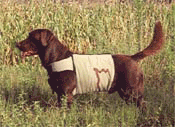 So, here we are again... Another summer day, another 100 degrees. Will it ever end? And what about your dogs? Are they wondering if there will ever be another opportunity to go for a walk or chase a ball? I've tried explaining the dangers of heat stroke to my pups. I've told them that they cannot sweat except through their footpads and nose. And that the only other way they can cool themselves is through panting. Sometimes (like during current weather conditions) this is not enough to keep their bodies cool. If their internal body temperature reaches 106 degrees, they will experience damage to the body's cellular structure and damage to their organs that is IRREVERSIBLE. According to About.Com:Dog, signs of heat stroke are extreme heavy panting, dark red gums, tacky or sticky mucous membranes specific to the gums, heavy thick saliva, rectal body temperature exceeding 104 degrees (106 degrees is a dire emergency), lying down with refusal to get up, disorientation, dizziness and collapse and loss of consciousness. This is a serious medical condition that can lead to death and requires the immediate attention of your veterinarian. For more information go to:http://dogs.about.com/od/dogandpuppyhealth/qt/heatstroke.htm.
So, here we are again... Another summer day, another 100 degrees. Will it ever end? And what about your dogs? Are they wondering if there will ever be another opportunity to go for a walk or chase a ball? I've tried explaining the dangers of heat stroke to my pups. I've told them that they cannot sweat except through their footpads and nose. And that the only other way they can cool themselves is through panting. Sometimes (like during current weather conditions) this is not enough to keep their bodies cool. If their internal body temperature reaches 106 degrees, they will experience damage to the body's cellular structure and damage to their organs that is IRREVERSIBLE. According to About.Com:Dog, signs of heat stroke are extreme heavy panting, dark red gums, tacky or sticky mucous membranes specific to the gums, heavy thick saliva, rectal body temperature exceeding 104 degrees (106 degrees is a dire emergency), lying down with refusal to get up, disorientation, dizziness and collapse and loss of consciousness. This is a serious medical condition that can lead to death and requires the immediate attention of your veterinarian. For more information go to:http://dogs.about.com/od/dogandpuppyhealth/qt/heatstroke.htm. But the pleading look in the eyes of my dogs doesn't change. They don't understand what I am telling them or why. They really, really want some exercise. One solution may be for them to wear a canine cooling vest. Invented for military dogs working in Iraq and Afghanistan, the vests are also available for purchase for companion animals. How do they work? The vest sold by helpingudders.com uses packs of non-toxic, non-carcinogenic, environmentally friendly cooling gel that hold a constant temperature of 59 degrees Fahrenheit for 2-3 hours in 100 degree heat. These packs are placed in the vest that the dog wears. The packs are also easy to "recharge" simply by submerging the cooling packs in ice water for 20 minutes or placing the packs in the refrigerator for 30 minutes. The vests cost from around $99 to $129 depending on the size you need. You can also purchase additional cooling packs, so you always have one set in the refrigerator. Here is the website that carries canine cooling vests and where you can get more information: http://www.helpingudders.com/CoolingVests.htm This is a rescue friendly site where 10-50% of the proceeds of their sales go to rescue groups (unfortunately HOTLR is not one of them).
But the pleading look in the eyes of my dogs doesn't change. They don't understand what I am telling them or why. They really, really want some exercise. One solution may be for them to wear a canine cooling vest. Invented for military dogs working in Iraq and Afghanistan, the vests are also available for purchase for companion animals. How do they work? The vest sold by helpingudders.com uses packs of non-toxic, non-carcinogenic, environmentally friendly cooling gel that hold a constant temperature of 59 degrees Fahrenheit for 2-3 hours in 100 degree heat. These packs are placed in the vest that the dog wears. The packs are also easy to "recharge" simply by submerging the cooling packs in ice water for 20 minutes or placing the packs in the refrigerator for 30 minutes. The vests cost from around $99 to $129 depending on the size you need. You can also purchase additional cooling packs, so you always have one set in the refrigerator. Here is the website that carries canine cooling vests and where you can get more information: http://www.helpingudders.com/CoolingVests.htm This is a rescue friendly site where 10-50% of the proceeds of their sales go to rescue groups (unfortunately HOTLR is not one of them). Another seller of the dog vests uses slightly different technology. They utilize a cool pad that slips into the vest and stays at a constant temperature of 80 degrees Fahrenheit. This keeps dogs cool in warm temperatures and warm in cold temperatures. While 80 degrees seems warm, keep in mind that a dog's average body temperature is around 100 degrees and the 20 degree difference that the cool pad provides is enough to keep the dog's core body temperature at a safe level. Recharging the cooling pad works the same as for the packs described above. You can find these vests at http://www.50degree.com/custom/index.cfm?ID=42464. They are slightly more expensive running anywhere from $129 to $149 depending on the size ordered.
So, get back outside and give the canine cooling vest a try. (You can even buy a cooling vest for yourself) . Remember to limit exercise to early mornings or late evenings when the intensity of the temperature and sun is less. And of course, keep plenty of water available.

No comments:
Post a Comment